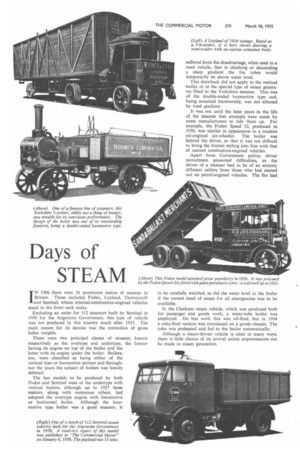Days of STEAM
Page 126

If you've noticed an error in this article please click here to report it so we can fix it.
IN 1906 there were 24 prominent makes of steamer in Britain. These included Foden, Leyland, Thornycroft and Sentinel, whose internal-combustion-engined vehicles stand in the front rank today.
Excluding an order for 112 steamers built by Sentinel in 1950 for the Argentine Government, this type of vehicle was not produced in this country much after 1933. The main reason for its demise was the restriction of gross laden weights.
There were two principal classes of steamer, known respectively as the overtype and undertype, the former having its engine on top of the boiler and the latter with its engine under the boiler. Boilers, too, were classified as being either of the vertical type or locomotive pattern and throughout the years the subject of boilers was keenly debated.
The last models to be produced by both Foden and Sentinel were of the undertype with vertical boilers, although up to 1927 these makers, along with numerous others, had adopted the overtype engine with locomotive or horizontal boiler. Although the locomotive type boiler was a good steamer, it
suffered from the disadvantage, when used in a road vehicle, that in climbing or descending a steep gradient the fire tubes would temporarily be above water level.
This drawback did not apply to the vertical boiler or to the special type of steam generator fitted to the Yorkshire steamer. This was of the double-ended locomotive type and, being mounted transversely, was not affected by road gradient.
It was not until the later years in the life of the steamer that attempts were made by some manufacturers to tidy them up. For example, the Foden Speed 12, produced in 1930, was similar in appearance to a modern oil-engined six-wheeler. The boiler was behind the driver, so that it was not difficult to bring the frontal styling into line with that of current combustion-engined vehicles.
Apart from Government policy, driver recruitment presented difficulties, as the driver of a steamer had to be of an entirely different calibre from those who had started out on petrol-engined vehicles. The fire had
to be carefully watched, as did the water level in the boiler if the correct head of steam for all emergencies was to be available.
In the Clarkson steam vehicle, which was produced both for passenger and goods work, a water-tube boiler was employed. On bus work this was oil-fired, but in 1914 a coke-fired version was introduced on a goods chassis. The coke was preheated and fed to the boiler automatically.
Although a steam-driven vehicle is ideal in many ways, there is little chance of its revival unless improvements can be made in steam generation.








































































































































































































































































